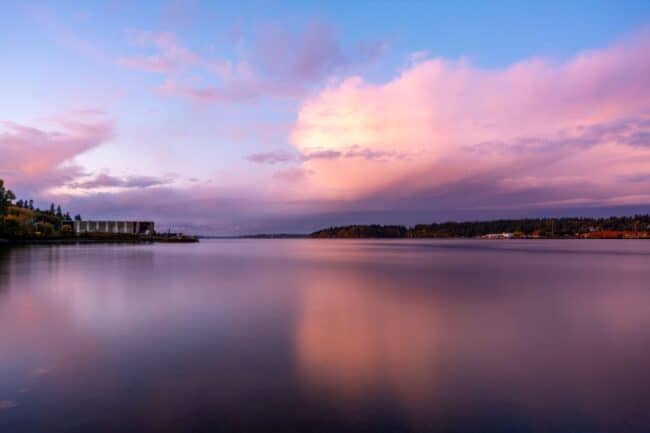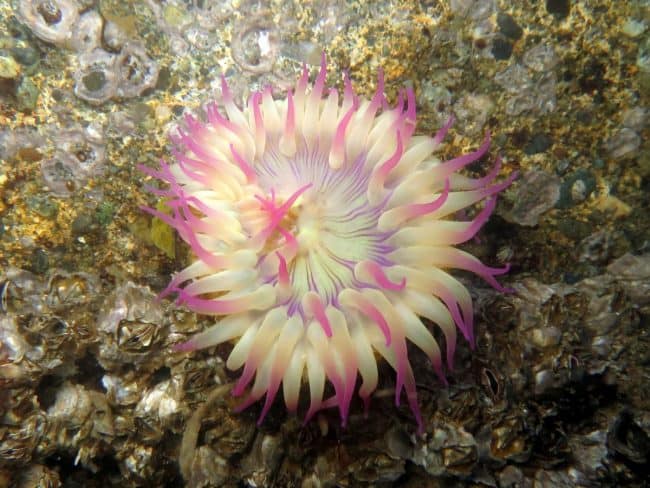The Puget Sound Estuarium was founded in 2007 by the South Sound Estuary Association (SSEA) as a nonprofit organization. Their mission is to foster learning opportunities that inspire people of all ages to enjoy the unique estuary* environment of Puget Sound.
* Estuary: where a river meets the sea, mixing fresh water with salt water. The word estuary comes from the Latin word aestuarium meaning tidal inlet of the sea, derived from the word aestus, meaning tide.
About Estuaries
Estuaries carved by glaciers, such as Puget Sound, are known as fjord estuaries. They are prominent in areas where the glaciers once loomed, including Alaska and Scandanavia in the Northern Hemisphere and Chile and New Zealand in the Southern hemisphere.
The more common type of estuary, called coastal plain estuaries, were formed when a rising sea level flooded a major river valley. Coastal plain estuaries, including Chesapeake Bay on the East Coast and Coos Estuary in Oregon, tend to be shallower with less physical diversity than fjord estuaries. More info: 2015 Puget Sound Fact Book v3.1 (eopugetsound.org)
Chesapeake Bay is the largest estuary in the United States, occurring in parts of six states — Delaware, Maryland, New York, Pennsylvania, Virginia, West Virginia, and the District of Columbia. Chesapeake Bay covers about 4,480 square miles—more than four times the area of Puget Sound (not including waters north of Whidbey Island). More than 150 rivers and streams drain into the Bay.
However, Puget Sound is the largest estuary system in the United States by volume of water (and second largest by shoreline). Chesapeake Bay is shallow, averaging just 21 feet deep. In comparison, Puget Sound averages 205 feet deep. Consequently, Puget Sound can hold a more massive volume of water, some 40 cubic miles—well beyond Chesapeake Bay’s volume of 18 cubic miles. An estimated 2,800 streams—from large rivers to small creeks—flow into Puget Sound.

Sunset over Puget Sound’s Budd Inlet in Olympia, Washington – photo by John Callery via iStockphotos by Getty Images
About Puget Sound & Deschutes Estuary
The Puget Sound Estuarium in Olympia is home to live estuary animals, exhibits, specimens and more! The community is invited to explore the animals and plants in our estuaries, where freshwater and saltwater meet, and learn what is unique about this delicate, vibrant ecosystem so vital to our region. Knowledge helps you and me take better care of our shared natural resources and act in ways that protect the ongoing health, conservation, and restoration of south Puget Sound.
The Deschutes Estuary/Capitol Lake is the southernmost point of Puget Sound. It is part of the Puget Sound estuary system and has local ecological, cultural, and economic significance. While Capitol Lake is a relatively recent alteration, the Deschutes Estuary has existed since the end of the last ice age and is the ancestral land of the Steh-chass people whose relationship with the Deschutes Estuary traces back through time immemorial.
The facility features five tanks featuring an amazing diversity of animals from intertidal and subtidal environments in South Puget Sound. Animals include sea stars, anemone, shellfish, crabs, and more. Permanent Exhibits at the Estuarium explore intertidal life in the Puget Sound and the impacts of human life on the ecosystem. Topics include aquaculture, climate change, pollution prevention, and first peoples of the Salish Sea. Rotating Exhibits highlight special topics and often feature special guest speakers, demonstrations, and activities such as dissections led Estuarium interpreters.
In addition, the specimen collection includes preserved creatures from the depths of Puget Sound and an extensive shell collection. Most specimens can be handled and observed. There is also an exciting array of short videos from local organizations and projects. And finally, visitors can explore the microscopic world of Puget Sound native flora and fauna with their collection of slides.
Visiting Puget Sound Estuarium
Stop by during open hours to explore Salish Sea education.
- Location: Puget Sound Estuarium, 309 State Ave NE, Olympia, WA 98501
- Hours: Saturday & Sunday: 11:00 – 4:00 PM.
- Admission: $8/family, $5/adult, $3/youth (18 and under), Free with EBT
- Website: Puget Sound Estuarium (pugetsoundestuarium.org)
Throughout the year, the Estuarium offers many programs and special events to enhance your returning visits. Read more about some of these programs below.

Aggregating or Clonal Anemone (Anthopleura elegantissima) are an abundant species found along the Pacific coast photo by randimal via Depositphotos
Puget Sound Estuarium programs
Discovery Speaker Series. Every 1st Thursday at 6:30PM from October – March. Talks and Q&A sessions with artists, educators, scientists, and Earth advocates. These talks are free and in-person at Olympia Library. More info: Events | Timberland Regional Library and Discovery Speaker Series – Puget Sound Estuarium
Volunteers: The Estuarium is always looking for enthusiastic people to be a part of the Puget Sound Estuarium as a volunteer. Volunteering is a great opportunity to learn more, gain experience, connect with other volunteers and the community, and make a difference in the health of Puget Sound through education. More info: Volunteer – Puget Sound Estuarium
Pier Peer: Year-round our trained staff and volunteers run our popular Pier Peer program on local docks after dark in Thurston and Mason Counties. Our trained team provide underwater lights that attract spectacular estuary creatures for you to scoop up and observe. From octopus to anemones, from sea stars to sea slugs, you never know what you’ll encounter! More info: Pier Peer – Puget Sound Estuarium
Meet the Beach: During our Meet the Beach program our dedicated team of volunteers, called Beach Naturalists, connect beach goers with our unique estuarine ecosystem by identifying intertidal life during summer low tides. More info: Meet the Beach – Puget Sound Estuarium
Event calendar of free and affordable things to do
Listed below are all types of free and affordable things to do in the next 30 days.
Featured Events are listed first each day, highlighted by a photo. These are unique, popular, or annual events that we or our advertisers don’t want you to overlook.
Find more events and ideas for affordable living at Greater Seattle on the Cheap – Free things to do, cheap fun, discounts and deals in the Seattle-Tacoma metro area








